NOTE: although bicycles, motor scooters and, in all countries except Japan, 3- and 4-wheeled carts (a few of them motorized) were pervasive throughout Asia, I saw no more than a handful of strollers throughout all the countries visited, and those were usually at the airport (I remember seeing only one in Thailand). Most of the children are carried or they walk.

A street in Hong Kong.
Detectable warning surfaces extended the width of the curb ramps.

The tiles are installed so the rows of bumps on the detectable surface are aligned with the direction of the crosswalk.
I explained to the students at Okayama Prefectural University that this is not permitted in the U.S., where the bumps should be perpendicular to the edge of the ramp (for people in wheelchairs, the wheels move more easily between the rows of bumps, and their chairs may lose stability if they can't navigate through the ramp at a perpendicular angle).

A person in a wheelchair travels through the subway system in Hong Kong.
In every country we visited, all transit stations as well as many malls and hotels had tactile trails leading to features such as stairways and elevators, train platforms, bathrooms, etc., as seen here along the hallways.

Train station in the city of Marugami on the island of Shikoku, Japan.

Crosswalk in Hiroshima, Japan.
All countries visited (Bangkok, Hong Kong, cities in mainland China including Guongzhou and Shanghai, and cities throughout Japan) had strips with tactile bars along at least some of the sidewalks, with truncated domes at any points where there was a tactile trail leading to something of interest to the side, such as a crosswalk or bus stop. A few places in Japan had no tactile strips along the sidewalk but had tactile strips crossing the sidewalk at points of interest, such as mid-block crosswalks.
In the United States, the use of truncated domes is restricted to indicate hazards such as the edges of streets, platforms and fountains. Extensive use of truncated domes to give wayfinding information as well as marking the edge of streets and platforms may make their meaning ambiguous.

A drainage grill runs parallel to the tactile marking strips along this sidewalk by Peace Garden in Hiroshima, Japan.

The automatic ticket machine at the train station in Kyoto and other cities has an assistant posted to help travelers use the machines to purchase their tickets.

A crosswalk at a narrow street near the train station in the city of Marugami on the island of Shikoku, Japan, had an unusual tactile trail along the sidewalk and the edge of the crosswalk, as the tiles were about half as wide as most tactile tiles, and the strip along the sidewalk was not continuous.

While most curb ramps in the larger cities had detectable warnings, many crosswalks in smaller cities did not.
(shown: city of Marugami on the island of Shikoku, Japan).

Count-down signal in Marugami, Japan shows decreasing numbers of lighted bars rather than decreasing numbers (green for "walk," red for "wait").





This young woman travels the subway system of Kyoto by herself in her motorized wheelchair. She says she can get around most places but sometimes needs help for access. Click here for more story in the Diary from Asia.
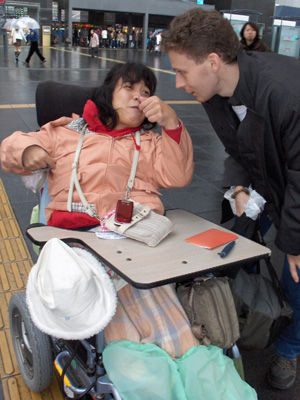
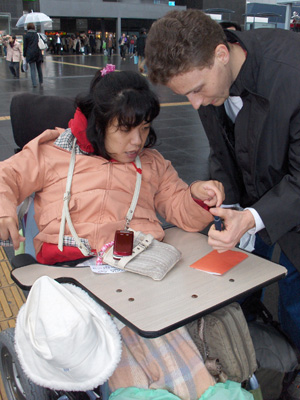
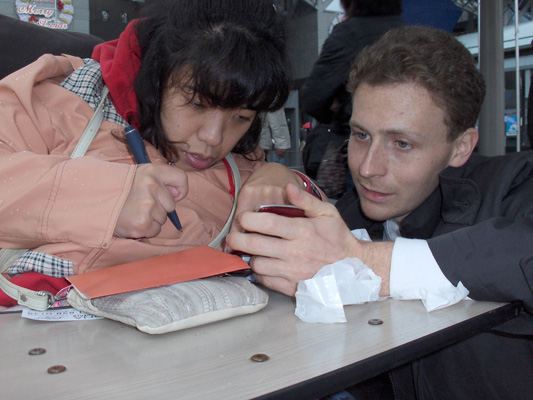
This bus stop (below, left) in Kyoto, Japan, has an awesome signage system to indicate the approaching buses both visually and audibly. There are 4 buses that pass this stop, and the sign has 3 openings for each bus, indicating that the bus is 5 minutes away, 2 minutes away, or within sight - when it is within sight, it is announced audibly. The sign below (middle) indicates that bus 100 and the 206 bus to Shuo are about 5 minutes away, the sign on the right indicates that bus 100 is about 2 minutes away, bus 206 is within sight of the stop, and bus 208 and the other bus 206 are both about 5 minutes away. Click here for more details.
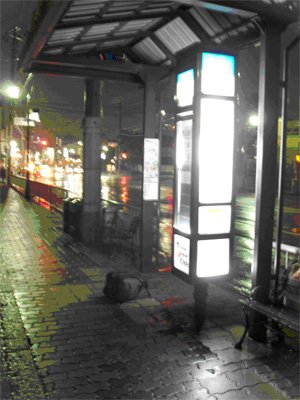
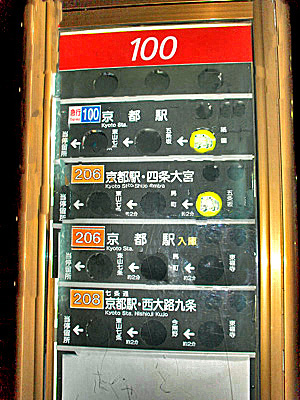
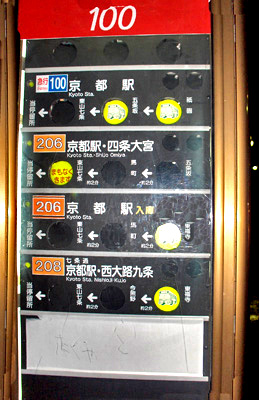
The railing of a stairway of this 5-story game store in Kyoto, Japan is labeled in Braille to indicate which floor is at the bottom and top of each stairway. Many stairs throughout Asia had detectable warnings at the top and bottom.




Cones along this construction site in Tokyo, Japan light up at night.
Many streets in Hong Kong barricaded the curb where pedestrians were not supposed to cross, making it easier to find the crosswalk. This street is intended to be crossed half at a time. When pedestrians reach the middle, they reach a barricade that must be followed to an opening to the left where they can complete the crossing. This signal (and all signals I saw in Hong Kong) were accessible - there was a constant ticking sound that could be heard near the crosswalk, and the time to cross was indicated with a change in the speed of ticking.




The ticking of the signal is generated from boxes on poles near the crosswalk. The ticking can be felt tactually with a vibratory button on the bottom of the box (right, below).



There are about 10,000 accessible pedestrian signals (APS) in Japan, according to Dr. Kunio Kurachi of Mitsubishi, but many intersections do not have accessible pedestrian signals, including this one at the crosswalk at the entrance of Tokyo University, where there are blind students. This appears to be a difficult crossing without APS because it is essentially a T-intersection with the entrance to the university, and the parallel traffic (which usually serves as the cue to cross) from the entrance is sometimes sparse.
A screen inside each car on this Tokyo subway visually indicates how many minutes to each of the stations ahead, updating that information at each stop. The photo below (enlarged to the right) was taken when the train was two minutes away from Tokyo station, as indicated by the red arrow.



The same screen changes to indicate other information, as shown here.
Return to Diary from Asia
Return to home page